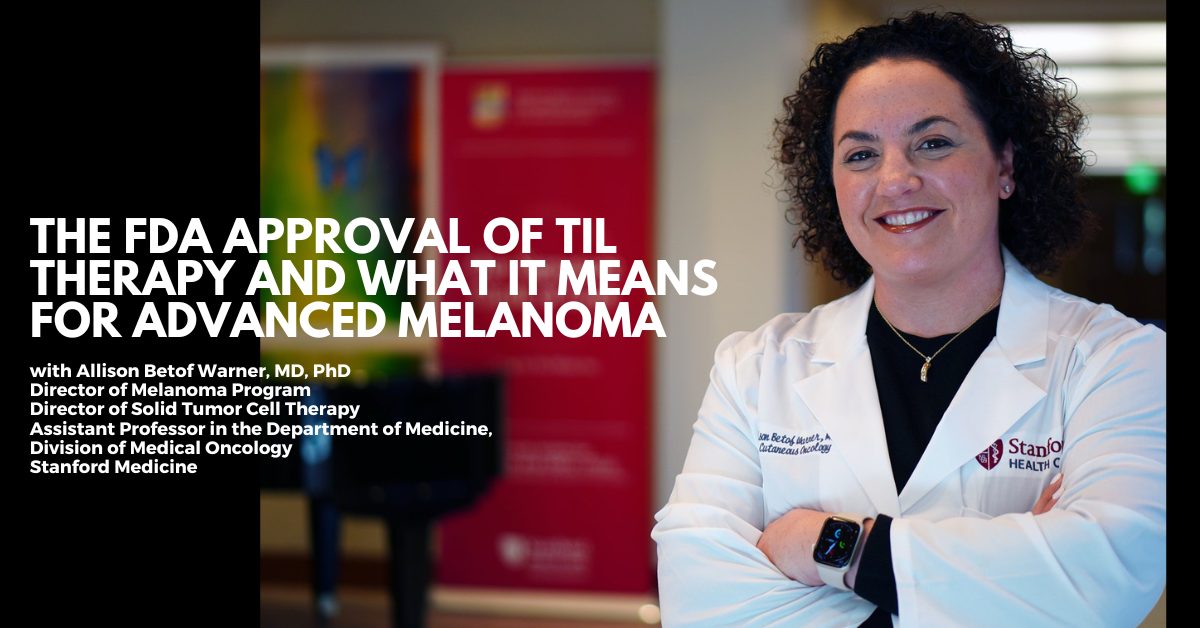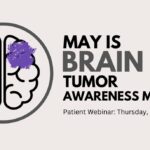
The following is an edited and shortened version of our recent interview with Allison Betof Warner, MD, PhD about the newly FDA approved treatment for melanoma called lifileucel (Amtagvi), TIL therapy or TILs, for tumor-infiltrating lymphocytes. To watch the full webinar, click here.
What is TIL therapy (Amtagvi™ or lifileucel), and how does it work?
TILs stands for tumor-infiltrating lymphocytes and is another form of immunotherapy. Immunotherapy in melanoma usually means checkpoint inhibitors, which are drug treatments that activate a patient’s immune cells so they can seek and kill tumor cells. By contrast, TIL therapy is a cellular therapy that administers immune cells to a patient, rather than using a drug to activate immune cells.
The general idea is that some patients will get traditional checkpoint inhibitors and their immune system will become activated. Treatment is successful when enough immune cells are able to find and kill tumor cells. However, sometimes not enough of those immune cells find the tumor. TIL therapy approaches this problem a slightly different way. With TIL therapy, a piece of the tumor is removed to extract the immune cells that were able to find and attack the tumor. Those active tumor cells are expanded into the billion-fold range and then returned to the patient.
Patients will have surgery to remove between 1.5 and 4 centimeters of tumor, which is then sent to a company. In the case of TILs for melanoma, the company is Iovance, and they process the tissue and remove the tumor cells. Iovance then grows the good T cells and returns them as a frozen product.
Patients will then receive up to seven days of chemotherapy to get rid of the immune cells that do not work. This treatment also gets rid of the cells and suppressive signals that could compete with these new immune cells that we plan to give back to the patient. Then, we provide the patient with their expanded immune cells and a medicine called high-dose IL-2 that helps keep those cells active and alive.
What is IL-2?
IL-2, or interleukin 2, is an older medicine. If you have ever had the flu, a high fever, and shaking chills, your body is making IL-2 to trigger an immune response. IL-2 is a natural molecule that your body makes to turn on your T-cells. We give it at higher doses. It is a cytokine, a signaling molecule that turns on T-cells in the body.
What is the length of time that patients are in the hospital for TIL therapy and what is the recovery time?
Every patient is different, and every center does this differently. Some centers will admit the patient to the hospital for chemotherapy. Centers that see a lot of patients with cellular therapy or bone marrow transplants will often give chemotherapy as an outpatient treatment. Chemotherapy accounts for five to seven days of the total admission time.
Everyone will get the cells and the IL-2 in the hospital. Cells take one day. IL-2 takes up to three additional days after that. Most patients are hospitalized for 10 to 14 days after cell treatment. The total length of the hospitalization is dependent on how quickly people recover from the chemotherapy and the IL-2. In addition, the rate at which the blood cells return after chemotherapy is essential. We can give estimates, but everyone is going to be markedly different.
How long does it take to grow an adequate number of T-cells to put back into the patient after the original tumor harvest?
In clinical trials, the production time was about 22 days. The actual time between when they come out of a patient and when the clinician gets them back to give the cells to a patient with the approved product is 35 days. That difference is because those cells need to undergo a ton of testing to ensure that they are not infected with anything before they are put back into the patient. Then the company (Iovance) makes sure the cells are expanded, healthy, and alive; extra testing makes the total period 35 days.
Who is eligible for TIL therapy?
TIL therapy is a brand-new and highly complex therapy. The patients who are good candidates for TIL therapy are up and active during the day, able to do their work around the house or work full or part time, and maintain their body weight. That’s the kind of patient who will do well with TIL therapy.
A few categories of patients are expressly excluded from receiving TIL therapy. For example, uveal melanoma is not included in the FDA approval. There are ongoing clinical trials for TILs in uveal melanoma, but patients with uveal melanoma are not at this time eligible for the FDA-approved product. Patients need to have good heart and lung function. The function of those organs will be tested as part of the workup. It’s not safe to give TIL therapy if patients do not have good heart, lung, and kidney function. The patients must be well enough to make it through the chemotherapy and the IL-2 therapy, both filtered out by the kidneys.
Patients who are on treatment-dose steroids, whether it is for brain metastasis or if it is because of an immunotherapy side effect, are not eligible for TIL therapy. The reason is because steroids inactivate the T-cells. Patients who have had a history of hypophysitis and are on replacement doses are okay to receive TIL therapy. Patients who are actively being treated on doses of steroids above 10 mg of prednisone are not eligible for TIL therapy until or unless they come off that steroid.
The last population of patients for whom TIL therapy is not appropriate includes those who have symptomatic or untreated brain metastases. We do not know whether TIL therapy is safe for these patients. High doses of chemotherapy can increase the risk of bleeding in the brain and is very dangerous. Brain metastases are at a high risk of bleeding and the IL-2 can cause swelling around a brain metastasis, which could be very dangerous. There are ongoing clinical trials looking at TIL therapy for patients with brain metastasis but the commercial product is not intended for the population with untreated metastasis. If brain metastasis is stable for a period of time after radiation therapy, then TIL therapy could be appropriate.
Which line of therapy is TILs?
The approval is second line or later. It is not approved for frontline therapy. There is a clinical trial going on that combines TILs with pembrolizumab, which could potentially become a frontline therapy. Still, it is a phase 3 trial that is now being enrolled. The FDA approval and most of the clinical trials for TIL therapy are for patients who have progressed on checkpoint inhibitors. If patients have a B-Raf mutation, they must have had, and not tolerated or not responded to, the BRAF/ MEK inhibitor combination therapy. Therefore, TIL therapy is a second-line or later therapy.
What kind of outcomes have we seen from this patient population?
The biggest trial with lifileucel (Amtagvi), the approved therapy, is the C-144-01 trial (NCT02360579). There were two separate cohorts, but all were patients with melanoma that had progressed on standard checkpoint inhibitor plus a BRAF+ MEK inhibitor, if they had the B-Raf mutation. In total, the trial enrolled 153 patients that met these criteria. The response rate was 31.4%, meaning that 31 out of 100 had their tumors shrink or disappear. That is not nearly as high as we would like it to be. Clinical trials are working to improve upon these numbers to bring up efficacy. However, the promise here is that over 40% of the patients whose tumors responded were still responding after 18 months plus. We expect that to be durable. These responding patients are also off all other cancer therapy with ongoing disease control.
A major clinical study that gave TIL therapy as second line after progression on anti-PD-L1 therapy showed that those patients do very well. Patients in that trial had a 50% response rate and a 20% complete response rate.
What about the side effects of TIL treatment, particularly with IL-2?
The biggest two sources of side effects in the whole process come from the chemotherapy and the IL-2. The TIL cells that are expanded and given back to the patient have very little toxicity.
The chemotherapy is a preparative regimen. Two chemotherapy drugs are given, cyclophosphamide and fludarabine. These are used for most cellular therapies. The main side effects of those agents include nausea and vomiting. We give patients lots of anti-nausea medicines, so these are minimized. Patients will lose their hair from this chemotherapy regimen.
The most significant risk is that the white blood cell counts will decrease. That puts patients at a high risk for infection. Red blood cells will also go down as a side effect of the treatment. Patients often need to be supported with blood transfusions during the process. Platelets go down as they also are part of this effect. Low platelets put patients at risk of bleeding, which is why patients with brain metastasis would be at an increased risk for bleeding. That is a critical issue.
Those counts will come back up on their own. Patients’ white blood cell counts are supported with a medicine called G-CSF. The medicine helps those white blood cells return faster to protect patients from infection.
The other side effects come from IL-2, but it has improved from years ago. The way we give IL-2 today is different from the way IL-2 was administered 20 years ago and we have even improved from the C-144-01 study. One of the things that we have learned throughout this process is that we can be less aggressive with the IL-2 treatment. However, this is a tough treatment. It is tough for the patients and their doctors. This treatment is very hands-on and involved. TIL therapy involves a huge team.
In the earliest days of TILs, we thought patients needed to get six or eight doses of IL-2. Some older regimens included more than 15 doses of IL-2. The toxicity of IL-2 is cumulative. Cutting that down helps the patient significantly. Many patients on IL-2 experienced fevers, shaking, chills, and low blood pressure. IL-2 causes capillary leak syndrome, when fluid leaks out of the bloodstream and goes into your hands and feet, which swell. The fluid can also go into the lungs and that causes patients to require oxygen. The combination of the blood pressure going down and fluid leaking out can damage the kidneys. Clinicians have learned to be very vigilant about these toxicities.
Recent data came out that changed the way clinicians think about TIL therapy. No data suggests more IL-2 is better for these patients. Some IL-2 is necessary based on previous trials that tried to leave it out and that did not work well. As soon as patients start running into side effects with IL-2, we can stop the treatment and the regimen’s efficacy is the same. Years ago, we were doing everything we could to keep going with patients on more IL-2, including monitoring blood pressure or putting them on blood pressure support medications or even on dialysis. Clinicians have learned they do not need to do that anymore.
How do the side effects of pembrolizumab, or any PD-1 inhibitor, compare to TILs?
The side effects are completely different. With checkpoint inhibitors, like pembrolizumab, the side effects result from auto-immunity, when the immune system turns on itself. That is not what we see with TIL therapy. With TIL regimens, the side effects stem from chemotherapy and IL-2 treatment. The main differences also include the duration. With TIL therapy, the side effects are mostly limited to the first 14 days, which is the time that the patients are getting chemotherapy and IL-2 and recovering in the hospital under close supervision. There are very few new side effects that appear after that. This can be an intense period, but it is a much more limited period.
With checkpoint inhibitors, the toxicities can last days, weeks or months. Sometimes they might even be lifelong.
If previous immunotherapy treatments caused multiple adverse events, will TIL therapy have more?
We have not seen that. Adverse events mediated by immunotherapy or checkpoint blockade occur when the T-cells get turned on, similar to auto-immune events. As long as those events have been completely resolved before TIL therapy, we have not seen it re-trigger the same side effects. The one caveat to that is the eye. The eye may experience uveitis. TIL therapy can cause uveitis, and it is essential to resolve any prior uveitis is resolved before treating a patient with TILs. Any patient who has had uveitis should have had an eye exam before the treatment with TILs to make sure that it has completely resolved.
What are other options for patients in whom TIL therapy did not work?
Go on to the next line of therapy, which can include several other options. They may choose to do a clinical trial after TIL. Some will choose to re-try a checkpoint inhibitor. After we have “reset” the immune response with TILs, there have been patients who then responded to checkpoint inhibition, even when they did not previously. We are trying to understand that further. The takeaway message is that TIL therapy is not the last line of defense. We think about it early if it is appropriate for the patient.
Is TIL therapy approved for mucosal and other types of melanoma?
Acral, mucosal, cutaneous, and melanoma of unknown primary origin are approved. These types of melanoma were included in the initial clinical trial and are appropriate for TIL therapy. Uveal melanoma was not included in the clinical trial and, therefore, is not part of the FDA indication.
Looking forward into the future, where are we heading with TIL therapy?
We are working on many things, including making better drugs – more efficacy, a higher response rate, and less toxic or safer for patients. As many patients have pointed out, not everyone is eligible for TIL therapy because of their age, a history of lung issues, a history of heart issues, or kidney problems. One of the biggest challenges here is the IL-2 therapy. If we could find a way to get rid of the IL-2 or minimize that amount people need, then many more patients would be eligible to receive TILs. Several trials and companies are working on that. A phase 1 clinical trial is now trying to eliminate the need for IL-2. That’s where we are going – eliminating the IL-2.
Getting rid of IL-2 in the regimen may also allow us to eventually move this treatment into outpatient treatment, as the IL-2 is the riskiest part of the treatment at this point. I do foresee a future with this being an outpatient treatment. That will be contingent upon what we can do to engineer cells that do not need IL-2 but do not have a lot of added toxicity.
Tell us about the centers that can offer TIL therapy
To become an authorized TIL treatment center, an arduous process is necessary for patient safety. Depending on the set-up of the center and what resources are already in place, hundreds of hours of work may be needed. Then, there is an evaluation process, and an on-site audit, and the center must have certain clinical teams in place with safety measures and checkpoints.
The drugs website lists authorized treatment centers. There are 26 authorized treatment centers in the U.S. right now. We expect that number to expand as more sites make it through this process. You can also find information about approved drugs and centers on the aimatmelanoma.org website.
What about insurance coverage?
TIL therapy is covered by Medicare as long as the patient meets all eligibility criteria. Private insurers are paying for this treatment, but the insurance approval process is not well defined yet. We usually have to contact the different companies with CMS and insurance codes. If a patient is appropriate, then insurance should approve the treatment. It may take an authorized treatment center to work on it and it may take some advocacy on the patient’s behalf. This is an exceptionally expensive treatment. The drug alone, just the cells, is $515,000. This does not include the IL-2, the hospitalization, or the chemotherapy. Insurers are trying to figure out how to do this. The surgery is not included in that cost. The surgery and treatment need to get approved. For patients who meet the eligibility criteria, this should be approved, but it may need some work because it’s new. We are teaching the insurers about it.
Entradas recientes

Navigating the Journey Together – Conversations with Melanoma Caregivers

May is Brain Tumor Awareness Month

President’s Letter | April 2024

Celebrating a Milestone: 20 Years of the Dallas Steps Against Melanoma Walk

